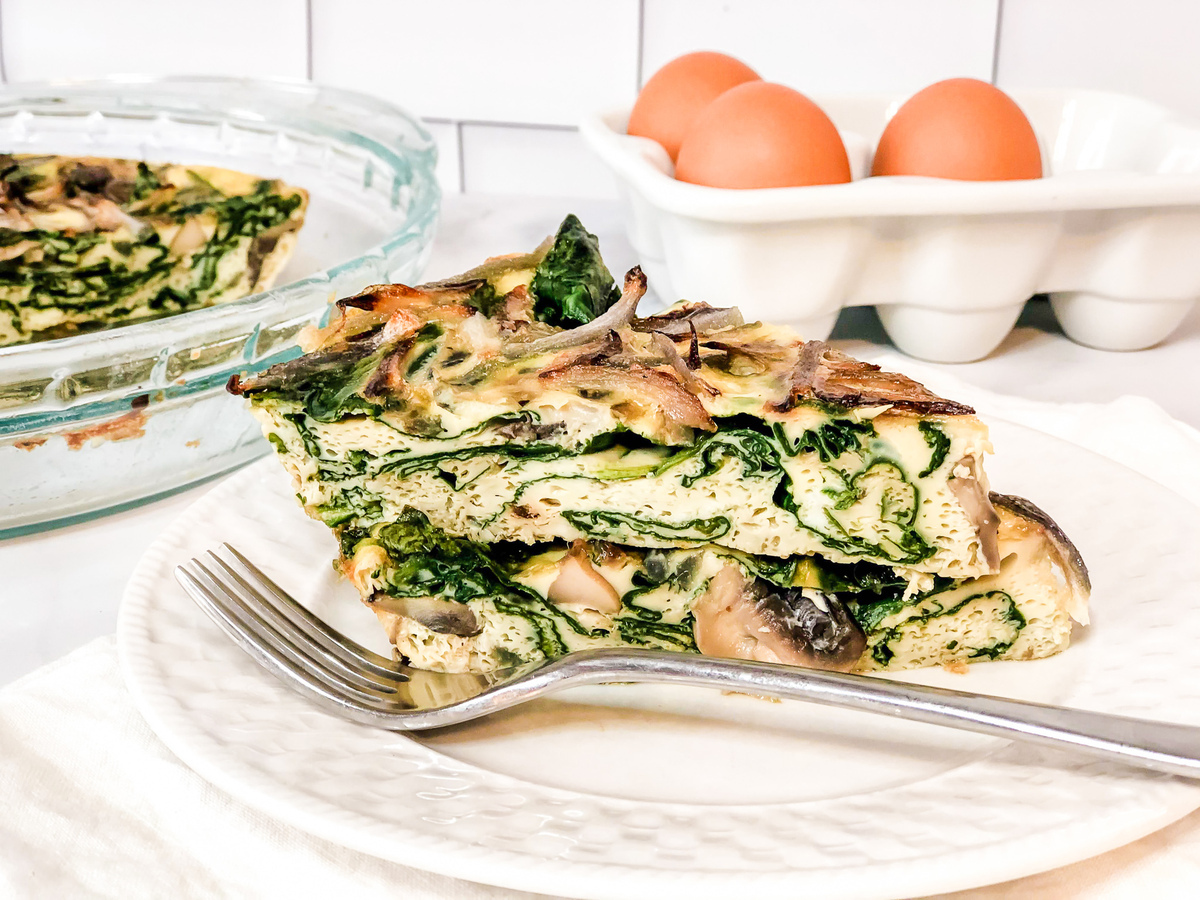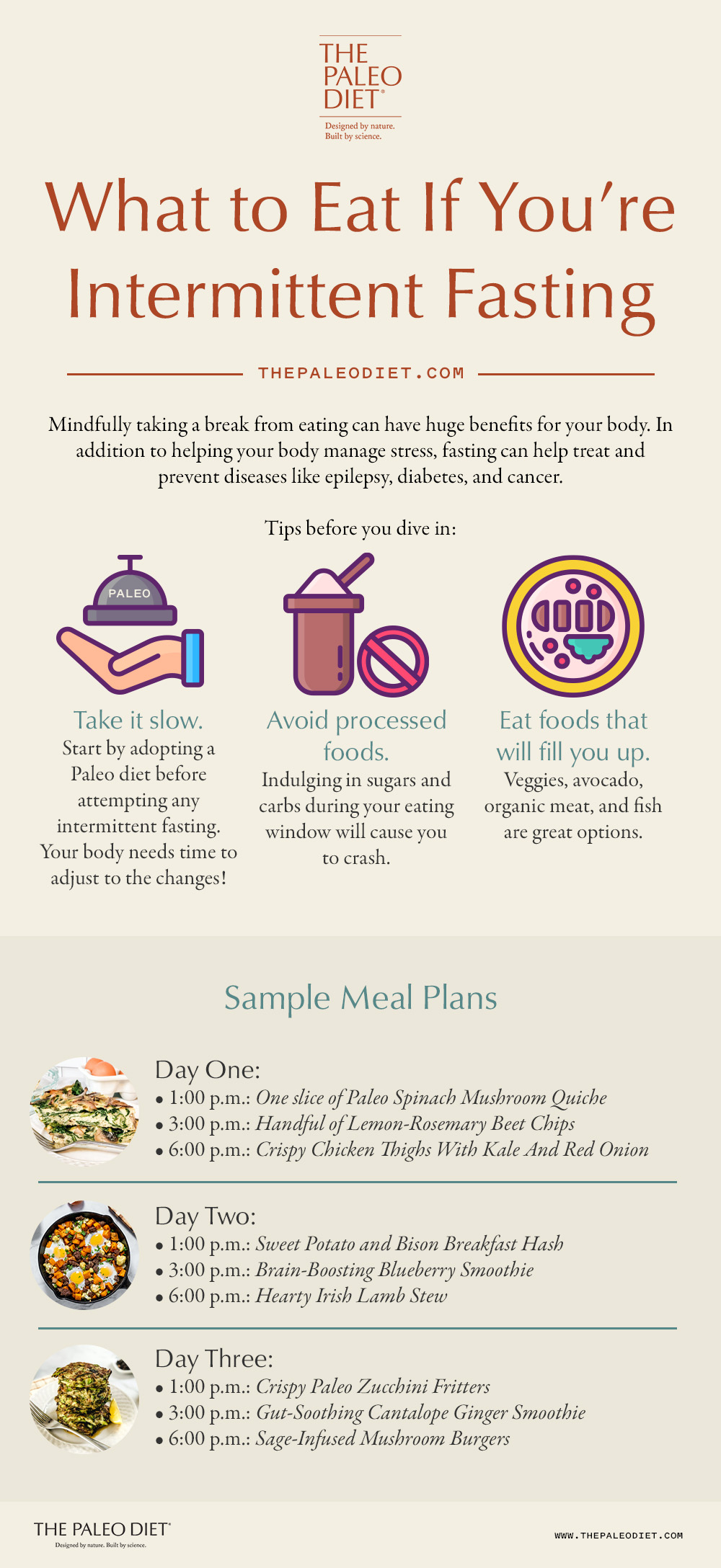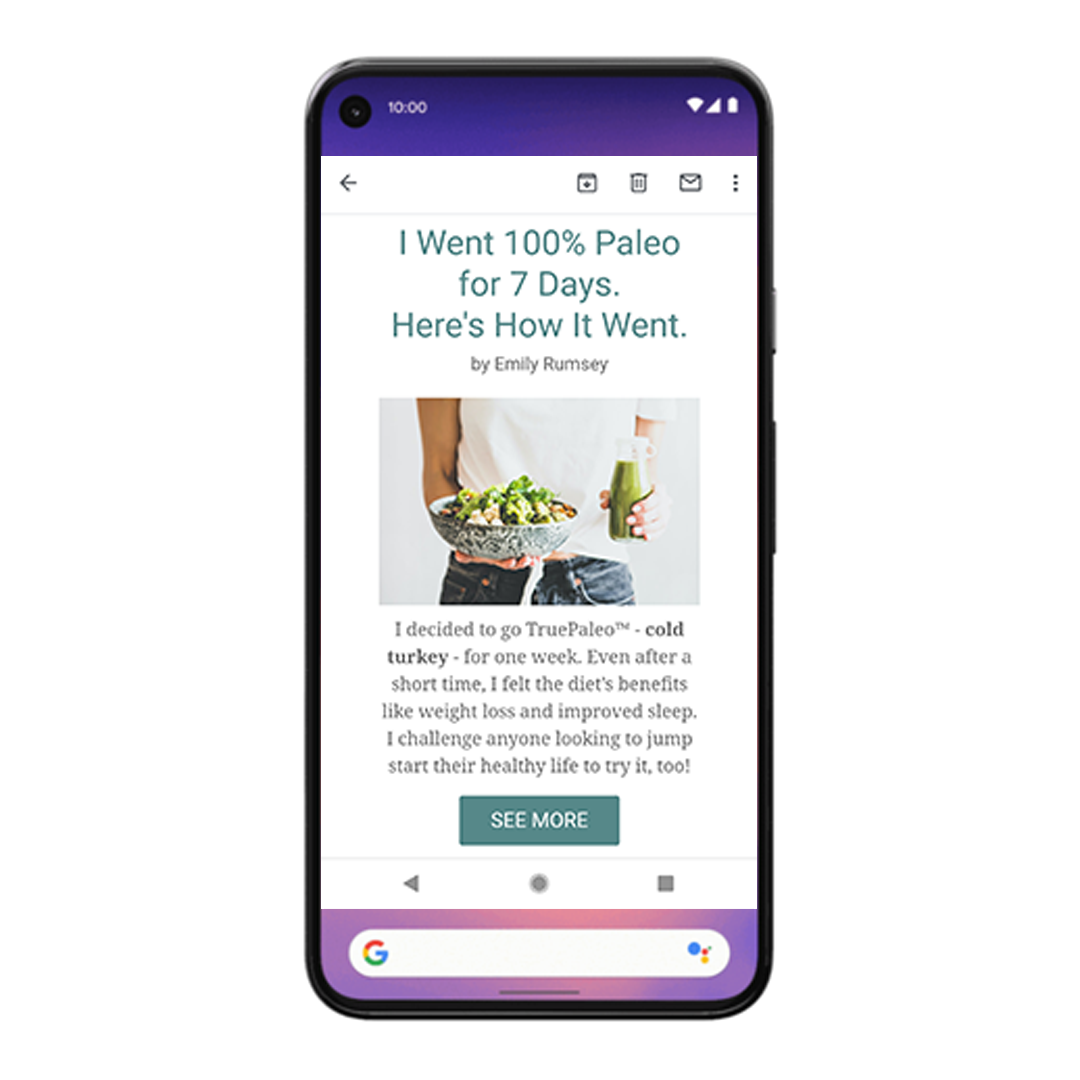What to Eat During Intermittent Fasting

For thousands of years, fasting has been practiced for spiritual purposes, as a method to help treat various diseases, or because of a simple lack of food. Today, intermittent fasting (IF) is a wildly popular eating style with goals of weight loss, mental clarity, and more. But the foods you eat during intermittent fasting can have a big impact on the benefits. Here’s our guide that shows how The Paleo Diet can make intermittent fasting much more sustainable and effective.
Fasting as a method to treat diseases showed success even in ancient times, with Hippocrates claiming that fasting could prevent or lessen the severity of epilepsy. [1] Now, modern research on fasting has exploded, with hundreds of studies showing many benefits of intermittent fasting like increased stress resistance, decreased risk of diabetes, longevity, and even reduced cancer risk. [2] Our contributor Bill Manci recently explored some of these newly discovered benefits of intermittent fasting.
Contrary to popular belief, what you eat between fasts can make or break your experience. Here’s how to maximize your eating time to make sure you fuel yourself properly through the process.
Start Fasting Slowly
First of all, if you are considering trying intermittent fasting, go slow and begin with some care and planning. Many people jump into intermittent fasting and hit a wall immediately. If you’ve tried it, perhaps it left you light-headed, irritable, shaky, and weak … not to mention extremely hungry!
What You Eat During Intermittent Fasting Matters
It’s a common belief among the intermittent fasting community that, because you are eating within a smaller window during the day, you can eat whatever you want and still avoid gaining weight. The logic goes that it should be difficult to get in enough calories for the day in such a short time frame (typically a 6–8-hour window).
There’s also a lack of discussion and understanding about what types of foods you should be eating at mealtime.
True, some people can get away with eating whatever they desire during their eating window and not gain weight; however, this doesn’t necessarily mean that their strategy is healthy. It simply means that their calories isn’t high enough to cause them to gain weight.
The problem with taking the “eat whatever you desire” advice during your eating window is that it is not only unhealthy advice, but it can easily backfire for most.
Why?
Starting Intermittent Fasting Shocks Your Body
Simply put, fasting (especially if you’ve never practiced it before) is a bit of a shock to your body on various biochemical levels. If you’re eating a high-carb diet or a typical Western diet now, making a quick move to intermittent fasting can be especially challenging. Fasting will take a bit of metabolic readjustment to get used to.
What do I mean by “metabolic readjustment?” For example, if you take a person who has been consuming high amounts of processed carbs and sugars, which have been spiking their blood sugar for years, then suddenly remove all glucose and sugar from their diet for a huge chunk of time, that person is going to likely experience an intense case of low blood sugar.
This will lead to them feeling shaky, light-headed, exhausted, and irritable. They may then feel “better” once they get their familiar spike of glucose during their feeding window, but because they are still eating processed carbs and sugars, they will crash immediately during their fast. And, unfortunately, this may cause them to give up fasting before their body ever has the time it needs to metabolically readjust to burning fat instead of glucose as a fuel source.
Transition To a More Paleo Diet First
Now, contrast this with someone who has been eating a Paleo Diet of natural carbohydrate sources that don’t spike their blood sugar. Because their bodies are used to dipping in and out of their fat stores, they will likely better adjust to intermittent fasting.
To truly succeed and thrive on an intermittent fasting regime, we recommend that you first shift to a way of eating that is closer to The Paleo Diet guidelines before you try intermittent fasting. See our guide on how to gradually transition to The Paleo Diet.
Consuming vegetables, whole fruits, and eating plenty of wild proteins and healthy fats will help your body adjust to lower glucose levels before you dive headfirst into glucose scarcity for many hours a day.
We recommend shifting to The Paleo Diet for at least a couple of weeks before jumping into intermittent fasting. See our free guide How to Go Paleo to get started.
So let’s say you’ve been eating a more Paleo Diet for a few weeks and you’re adjusting nicely to a lower carb and higher protein diet that is smoothing out your blood sugar. What’s next?
What to Eat While You’re Intermittent Fasting
During your feeding window, the same rule applies: Keep it Paleo, and avoid processed carbs and sugars, as these will spike your blood sugar and cause you to feel a “crash” during your fast.
Here are the three types of foods you should focus on.
1. Healthy Fats
Fats are key to making sure you’re getting enough calories during your fast, since your eating window is smaller. Eating healthy fats assists with satiation.
Eat plenty of avocado, cold-pressed olive oil and coconut oil, coconut milk, seeds and nuts, and eggs.
2. Natural Meats and Seafood
High-quality protein like those from natural, minimally processed, and organic meats and seafood, is going to keep your blood sugar stable and keep you feeling full for hours.
Eat plenty of grass-fed beef, pasture-raised poultry, wild game meats, and fish like wild-caught salmon, sardines, and mackerel.
3. Fresh Fruits and Vegetables
Make sure you’re getting large portions of greens and non-starchy veggies with every meal, as these bulk up your feeding window with minerals and other essential nutrients. Supplement them with smaller servings of whole food carb sources. High-fiber fruits and vegetables will help you feel full longer.
Eat plenty of leafy greens like kale, collards, and spinach; starchy veggies such as sweet potato, pumpkin, and squash; berries, oranges, and avocado.
Different Fasting Schedules to Consider
One of the great aspects of intermittent fasting is the variability of fasting schedules you can adopt. For instance, some may choose to fast every other day, others may choose to eat only once per day, and others will eat only between a short window of time every day.
Here we focus on the latter version of IF, which shortens your “feeding window,” or the number of hours within which you consume food. The reason we’re doing this is because it is considered the most sustainable form of IF, and a great place to ease into the practice of fasting.
This method of IF is also referred to as the 16/8 method, and involves fasting for 16 hours, then feeding within the following eight hours.
In essence, this will look like skipping an early breakfast, then breaking your fast at either 11 a.m. to 1 p.m., and eating your last meal between 5 p.m. and 7 p.m.
Below you can see an example of what a day of this style of IF looks like.
Sample Meal Plan for 16/8 Intermittent Fasting

Ready to give IF a try? Here’s a meal plan for three days. You can try the 16/8 fasting schedule, or even use it for alternate-day fasting—just slightly increase your portions on your eating day.
Sample meal plan #1
- First meal, 12:30 – 1:00 p.m.: One slice of Paleo Spinach Mushroom Quiche
- Snack, 2:30 – 3:00 p.m.: Handful of Lemon-Rosemary Beet Chips
- Second meal, 5:30 – 6:00 p.m.:Crispy Chicken Thighs With Kale And Red Onion
Sample meal plan #2
- First meal, 12:30 – 1:00 p.m.: Sweet Potato and Bison Breakfast Hash
- Snack, 2:30 – 3:00 p.m.: Brain-Boosting Blueberry Smoothie
- Second meal, 5:30 – 6:00 p.m.: Hearty Irish Lamb Stew
Sample meal plan #3
- First meal, 12:30 – 1:00 p.m.: Crispy Paleo Zucchini Fritters
- Snack, 2:30 – 3:00 p.m.: Gut-Soothing Cantalope Ginger Smoothie
- Second meal, 5:30 – 6:00 p.m.: Sage-Infused Mushroom Burgers

References
1. Mark P. Mattson, Keelin Moehl, Nathaniel Ghena, Maggie Schmaedick, and Aiwu Cheng. Intermittent Metabolic Switching, Neuroplasticity, and Brain Health. Nat Rev Neurosci. 2018 Feb; 19(2): 63–80. <https://www.ncbi.nlm.nih.gov/pmc/articles/PMC5913738/>
2. Rafael de Cabo, Ph.D and Mark P. Mattson, Ph.D. Effects of Intermittent Fasting on Health, Aging, and Disease. New England Journal of Medicine. 2019; 381:2541-2551. DOI: 10.1056/NEJMra1905136. <https://www.nejm.org/doi/full/10.1056/nejmra1905136>
Megan Patiry
Megan Patiry is a freelance writer specializing in ancestral nutrition. She has personally followed a Paleo-style, ancestral style of eating for over a decade.
More About The Author




